UK: Transport for Wales has run its first Class 230 battery-diesel hybrid trainset in passenger service on the Wrexham – Bidston Borderlands Line. Tony Miles reports.
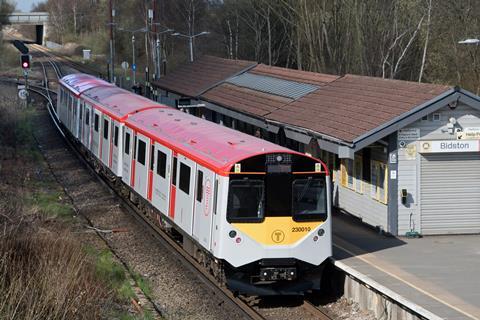
UK: The first of Transport for Wales’ Class 230 battery-diesel hybrid trains finally entered passenger service on April 3. The day was not without its problems, and it is expected to take some time for the trainsets to bed in and for drivers to become fully familiar with the new units.
The first revenue-earning trip was the 07.31 service from Wrexham Central to Bidston, operated by 230 010.
The rebuilt ex-London Underground train struggled to keep to the hourly timetable where, with around 58 min allowed for each journey, it is challenging to avoid delays accumulating. By late afternoon, the service was running 25 min behind the timetable and after the cancellation of one complete round trip, the day ended with the train coming to a stand with a compressor failure on the 17.42 from Wrexham Central to Bidston; it finally limped into Shotton 59 min late and was taken out of service.
Delays also built up on the second day of operation, but after the cancellation of a late afternoon round trip, 230 010 completed the final three journeys of the day in the booked timings.
Finally in service
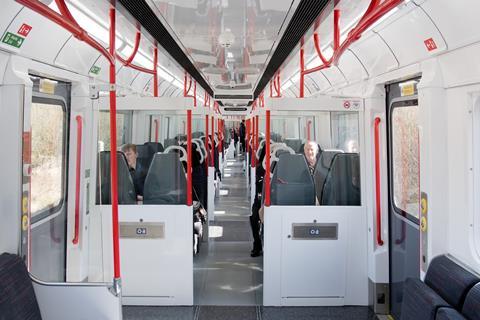
There was clear relief at TfW Rail to see the trains finally carrying passengers.
Entry into service had originally been scheduled for 2019, but was delayed by a series of setbacks including late delivery from supplier Vivarail in July 2020, the pandemic, a small fire on one train and the collapse of Vivarail into liquidation in December 2022. TfW Rail was forced to launch three separate driver training programmes as a result.
The decision to purchase outright the five three-car multiple-units from Vivarail prior to the supplier’s collapse proved to be wise, as it ensured that they could still enter service.
A number of former Vivarail employees on short-term contracts are supporting the fleet at Stadler’s Birkenhead depot where the units are maintained alongside the Merseyrail fleet.
Design
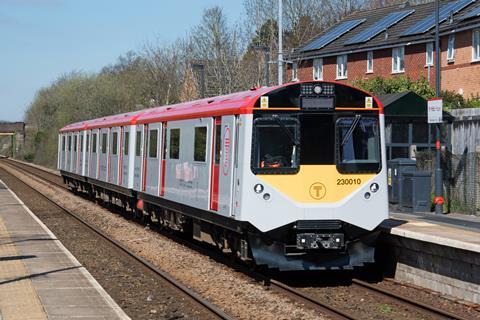
The Class 230s have been produced using former LU District Line D78 metro cars. The bogies and aluminium bodyshells have been retained, and the electronics and interiors completely replaced.
The five TfW sets 230 006 – 230 010 are the first Class 230 variants to have open gangways, and the internal specification is of higher quality than the similar trains supplied for West Midlands Trains and South Western Railway’s Island Line.
The TfW units also have a restyled front end. They retain the previous door spacing, with one door on each side of one of the driving cars removed to fit an accessible toilet, with a window opposite.
The seats are in 2+2 bays around tables, and AC and USB charging points are available throughout. There are two wheelchair spaces, electronic passenger information, wi-fi, cycle racks and air-conditioning.
Hybrid traction system
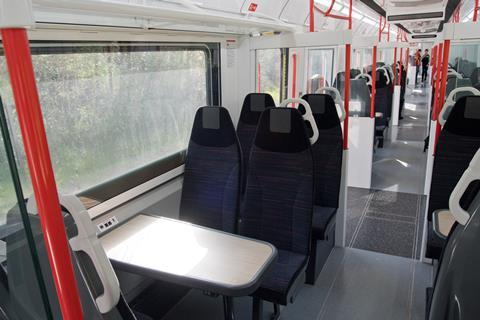
The trains use a battery-diesel hybrid traction drive featuring a pair of 100 kWh lithium-ion batteries in each driving vehicle,. These are recharged while the train is in service from a diesel genset powered by four Ford Duratorq 3.2 TDCi turbo-diesel engines in the centre car. Regenerated braking energy is also used to top up the batteries
The batteries enable the trains to accelerate at the same rate as electric trains, with three-phrase AC traction motors supplied by Traktionssysteme Austria giving a 96 km/h maximum speed. The diesel genset can also be used as a secondary source of traction power during a journey.
TfW’s original plan was for the engines to shut down completely at points along the route to reduce noise impact on nearby housing, but the geofencing now just drops the engines to idling speed at these locations. The project team is hoping for a 25% fuel saving over a conventional DMU.
Testing has confirmed that should the engines all shut down, a fully charged train can exceed the target distance range of between 65 and 80 km as planned by Vivarail during development of the design. This means that in most cases a train could complete its journey before returning to the depot.
Diagnostic systems enable engineers to identify any failing battery cells individually. A slow ‘reconditioning’ charge can often restore cells to full capacity, and any that fail completely can be replaced individually.
Performance like an electric train
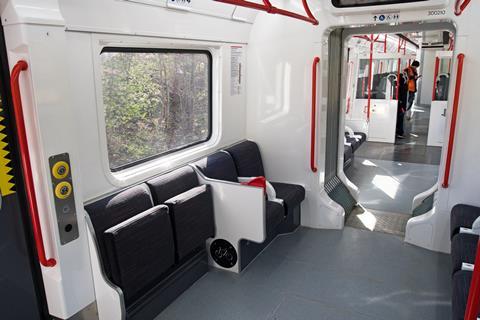
After the timekeeping issues on the first day, services were keeping to time by the end of April 4.
According to industry insiders, timing runs on the Borderlands Line had shown that the Class 230s can keep to sectional running times, with one TfW source telling Rail Business UK ‘the torque from these sets is high and instant, acceleration is quite amazing, but the drivers need to be confident and allow the traction control to do its stuff. Most drivers have only been used to diesel sets, the Class 230s have diesel engines but they perform like an electric train and it will take time for the drivers to get used to driving in a different way.’
Passenger services
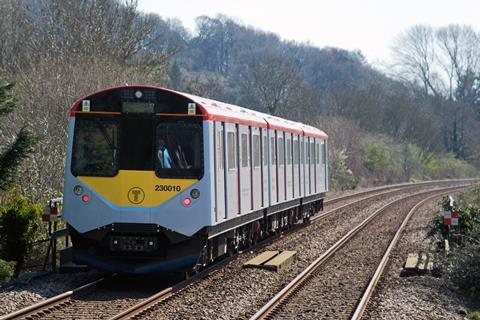
When originally procured, the Class 230 sets were to have been used on the Borderlands line and the Conwy Valley route between Llandudno and Blaenau Ffestiniog, but TfW subsequently decided to restrict the sets to Wrexham – Bidston services.
With availability initially expected to be low, it is likely that just two Class 230s will be in use each day, covering the hourly all-stations service. Additional services which are due to be introduced under a planned half-hourly headway will be covered by CAF Class 197 DMUs; these will only call at larger stations to ensure that the end to end journey is completed in under an hour.
TfW sources on the first train told Rail Business UK that there are still a number of minor issues to work through on the fleet. The recruitment of some ‘excellent former Vivarail people’ has given TfW the ‘benefit of their skills’, which will be particularly important in the procurement of parts needed to keep the trains in service.
The maintenance plan is based on having just two trains in service, increasing to three in the medium term. One option being evaluated would see a train used as a source of spares for the others; this unit would never enter passenger service.



